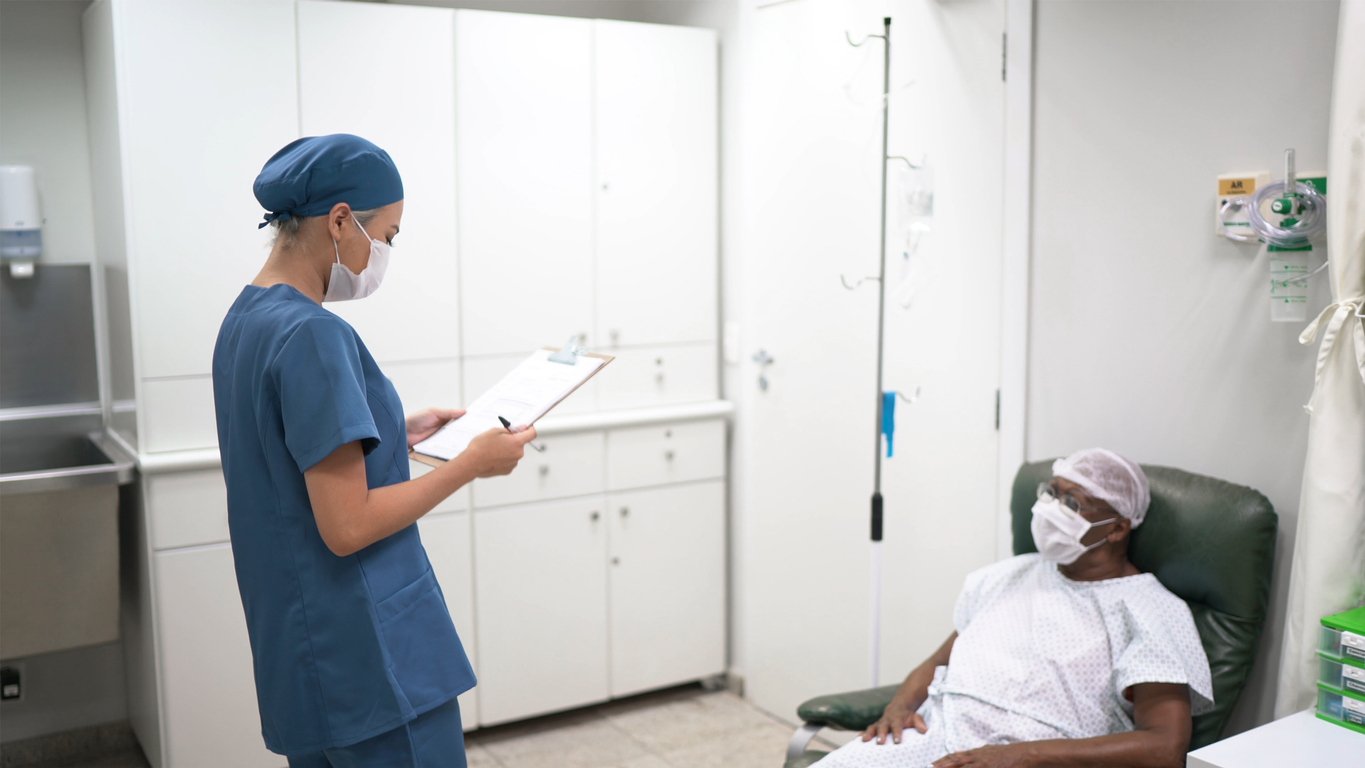<h3> <div style=”background: #e8edf0; padding: 10px 15px; margin-bottom: 15px;”>
<strong>Case report</strong>
A 54-year-old woman presented to our emergency department with abdominal distension and discomfort, which had been ongoing for over 13 months and had worsened in the prior six-to-eight weeks. The patient also reported urinary frequency and chronic constipation. She had previously been investigated with oesohago-gastro-duodenoscopy (OGD) and colonoscopy, which were negative. She presented one month prior to a medical service with deep vein thrombosis (DVT). A CT angiogram was negative as was an ultrasound and MRI of the liver. Her symptoms occurred on a background history of breast cancer, for which she received surgery, but discontinued chemotherapy and endocrine therapy due to toxicities.
Subsequent CT imaging revealed metastatic disease within the abdomen, a left-sided pleural effusion and a functional bowel obstruction. The tumour marker CA 125 was elevated at 729. She underwent urgent surgical diversion with loop ileostomy formation. The pathology result from surgery revealed poorly differentiated ovarian cancer (adenocarcinoma that was WT1 and PAX8 positive), which was extensively infiltrating the pelvis and abdomen.
Following recovery, she had three cycles of weekly paclitaxel and carboplatin modified to limit toxicities. Two months post-chemotherapy she underwent cytoreductive surgery, which involved en-bloc resection of the distal third of the colon up to the rectum, the uterus and appendix as well as stomal closure and side-to-side ileo-ileal anastomosis and pelvic lymph adenectomy. Chemotherapy was commenced post-operatively with carboplatin, paclitaxel and bevacizumab, which is ongoing. The patient is doing well and the latest CA 125 was 59. She has been referred to genetics as she was diagnosed with dual primary breast and ovarian cancer.
This case report demonstrates the usual late presentation of ovarian cancer and illustrates that even with advanced disease and obstruction, ovarian cancer can still be treated to improve quality-of-life and survival time.
</div> </h3> <h3><strong>Overview</strong></h3>
The majority of ovarian malignancies (95 per cent) are derived from epithelial cells, with the remainder arising from other ovarian cell types (germ cell tumours, sex cord-stromal tumours). There is an average of 384 new cases of ovarian cancer diagnosed and an average of 272 deaths caused by ovarian cancer each year, making it the sixth most common cancer and the fourth most common cause of cancer death in women in Ireland. According to the Irish Cancer Society, Irish rates of ovarian cancer are significantly higher than the EU average. Recent figures showed that in Ireland the incidence rate is 15.6 in every 100,000 women, compared with an average of 12.6 across the EU. Survival rates are slowly rising, and have increased by 3 per cent over the last 15 years.
<h3><strong>Usual and unusual symptoms</strong></h3>
Ovarian cancer has traditionally been considered a cancer with silent symptoms. Over 55 per cent of cases are diagnosed at stage III or above. This is primarily due to the occult nature of the disease. Presentation at a late stage may occur due to a symptomatic event, such as a bowel obstruction, malignant ascites or pleural effusion.
There are symptoms to be aware of which are subacute in nature and may lead to diagnosis of ovarian cancer. Unfortunately these subacute symptoms do not always indicate earlier disease stage and may not manifest until the late stages of disease. As such, the type or severity of symptom does not reliably correspond to disease stage.
These subacute symptoms have been given the acronym BEAT in an effort to raise awareness of investigating for underlying ovarian cancer. They have been validated by both the NHS and the Irish Cancer Society.
<strong>B</strong>loating that is persistent and does not come and go.
<strong>E</strong>ating less and feeling full more quickly.
<strong>A</strong>bdominal and pelvic pain you feel most days.
<strong>T</strong>alk to your GP about your symptoms.
Non-specific gastrointestinal symptoms or urinary urgency/frequency may also be symptoms of underlying ovarian cancer. Symptoms that warrant further evaluation for ovarian cancer are those that are new in onset, coexist with other symptoms, occur almost daily and are more severe than expected. It is important to remember that ovarian cancer may also present with unusual symptoms, unlikely to be attributed to ovarian cancer, including post-menopausal bleeding and rectal bleeding.
<h3><strong>Screening and risk</strong></h3>
Survival from ovarian cancer is related to the stage at diagnosis. Five-year survival is greater than 90 per cent for the minority of women diagnosed with stage I disease. This drops to about 75 to 80 per cent for regional disease and 25 per cent for those with distant metastases. Therefore, an appropriate screening programme could have the potential to significantly improve outcomes. However, at present screening for ovarian cancer has not been validated for either low-risk or high-risk women for identification of preclinical disease.
<h3><strong>Who is at risk?</strong></h3>
Risk of ovarian cancer increases with family history, smoking, asbestos exposure, nulliparity, hormone replacement therapy and polycystic ovarian syndrome. Multiparity, tubal ligation and oral contraceptive use are protective factors. The protective effect of oral contraceptives is sustained for over 30 years after stopping usage.
Family history is one of the most significant risk factors for developing ovarian cancer. Having even one affected first-degree relative triples the risk of developing ovarian cancer. A low-risk family history includes an isolated family member with ovarian cancer, without evidence of a hereditary pattern. A high-risk family history includes family members with a hereditary ovarian cancer syndrome, such as BRCA1, BRCA2 or Lynch syndrome. Thirteen per cent of women with ovarian cancer will have a BRCA mutation.
<h3><strong>Screening</strong></h3>
Serum CA 125 values are elevated in approximately 50 per cent of women with early-stage ovarian cancer and in over 80 per cent of women with advanced ovarian cancer. However, CA 125 levels are also elevated in approximately 1 per cent of healthy women and can fluctuate during the menstrual cycle.
CA 125 is also increased in a variety of benign and malignant conditions, including endometriosis, uterine leiomyoma, cirrhosis with or without ascites, pelvic inflammatory disease and cancers of the endometrium, breast, lung, and pancreas. Accumulated evidence to date suggests that annual CA 125 measurements alone lack sufficient specificity for use in an average-risk population of postmenopausal women.
A variety of other tumour markers, such as Human Epididymis Protein 4 (HE4), have been evaluated for their potential contribution to pre-clinical diagnosis of ovarian cancer, in combination with CA 125. None so far have been deemed to significantly improve sensitivity of ovarian cancer detection.
To date, randomised trials have evaluated screening with serum biomarkers, including CA125, transvaginal ultrasonography and multimodal screening with biomarkers plus ultrasound. The largest of these is the UK Collaborative Trial of Ovarian Cancer Screening (UKCTOCS). After 11 years of follow-up with annual transvaginal ultrasound (TVUS), there was no mortality reduction. Multimodal screening with annual CA 125, followed by TVUS if CA125 was abnormal, showed a trend towards reduction of mortality. However, the results were non-significant. Follow-up to confirm outcomes of the study are ongoing.
In summary, for women with average-risk, there is no evidence to support screening in this group due to inconsistent results in randomised trials and high rates of surgical interventions in false-positive findings.
Women with a low-risk family history should be counselled on screening options, the efficacy of CA 125 and TVUS for detecting early-stage ovarian cancer and the potential adverse effects of screening, including the potential for unnecessary surgical intervention.
Women with a high-risk of developing ovarian cancer (women with a high-risk family history or with suspected hereditary ovarian cancer syndrome) should be referred to a genetic counsellor for consideration of testing for BRCA1 and BRCA2 mutations and Lynch mutations. Risk-reducing surgery with hysterectomy and bilateral salpingo-oophrectomy is the only validated way to significantly reduce risk of developing ovarian cancer in this cohort of women but does not completely eliminate the possibility of peritoneal carcinoma.
<h3><strong>Staging</strong></h3>
Staging of ovarian cancer is by the International Federation of Gynaecology and Obstetrics (FIGO) or tumour-node-metastasis (TNM) staging systems. The following is the latest FIGO staging guidelines, updated in 2014:
<strong>Stage I – </strong>Tumour confined to the ovaries.
<strong>Stage II -</strong> Tumour involves one or both ovaries with pelvic extension (below the pelvic brim) or primary peritoneal cancer.
<strong>Stage III – </strong>Tumour involves one or both ovaries with cytologically or histologically confirmed spread to the peritoneum outside the pelvis and/or metastasis to the retroperitoneal lymph nodes.
<strong>Stage IV – </strong>Distant metastasis excluding peritoneal metastasis.
<strong>Survival</strong><strong> </strong>
Stage I – five-year survival – 83 per cent.
Stage II – five-year survival – 43 per cent.
Stage III – five-year survival – 24 per cent.
Stage IV – five-year survival – 15 per cent.
Overall five year survival in Ireland is 35 per cent vs 30 per cent 1994.
<h3><strong>Treatment </strong></h3>
<strong>Surgery</strong>
The standard surgical approach in ovarian cancer usually involves a laparotomy or laparoscopy with bilateral salpingo oophorectomy (BSO) and total abdominal hysterectomy (TAH), coupled with pelvic and para-aortic lymph node dissection, peritoneal washing, appendectomy and total ommentectomy. The goal is to remove all macroscopic tumours and diseased organs. This aggressive debulking improves survival and decreases the risk of post-operative ascites. Indeed, survival is inversely proportional to residual disease. Cytoreduction efficacy is divided into three categories:
Complete debulking achieves no visible disease.
Optimal debulking is residual disease <1cm.
Suboptimal debulking is residual disease >1cm.
<strong>Intraperitoneal chemotherapy</strong>
Intraperitoneal (IP) chemotherapy is performed in some select centres. Given that the most common site of spread of ovarian cancer is in the peritoneal cavity, this modality has a clear rationale and allows a several fold increase in drug concentration in the peritoneum compared with standard intravenous chemotherapy. According to current clinical data, patients with stage III disease who have been optimally debulked have the greatest survival benefit. Those with deposits >1cm remaining are not candidates as IP chemotherapy cannot penetrate into larger tumours. However, stage III clinical trials using IP chemotherapy in this group are ongoing.
Common complications include nephrotoxicity (particularly with cisplatin), catheter-related side effects, and more significant neurotoxicity when compared with IV therapy. It is a treatment modality not widely adopted at this time.
<strong>Radiotherapy</strong>
Radiotherapy is not widely used for the treatment of ovarian cancer. It can be used in palliation for reducing tumour mass effect on adjacent structures, but it currently has a limited role in active disease treatment. Between 2012 and 2014, only 2 per cent of those diagnosed with ovarian cancer received radiotherapy of some form.
<strong>Systemic treatment</strong>
The choice of systemic treatment for ovarian cancer is very much determined by clinical staging. Almost all stages will require initial surgical intervention, coupled with follow-up chemotherapy.
Stage Ia and b, where disease is confined to the ovary, have a 90 per cent survival rate with surgery alone. Currently, they are not treated with adjuvant chemotherapy and rather undergo postoperative surveillance for recurrence. In stage Ia, fertility-sparing surgery may be considered in select cases.
In stage Ic, II, clear cell histology, or high tumour grade, adjuvant chemotherapy is commonly used post-operatively. This is usually with paclitaxel and a platinum-based agent, such as cisplatin or carboplatin. This regimen is chosen as it has proven benefit in treating more advanced stage III and IV disease. Generally three-to-six cycles of chemotherapy are delivered.
For stage III disease, the option of upfront debulking surgery followed by six cycles of chemotherapy or chemotherapy first with interval debulking surgery followed by further chemotherapy are equally efficacious options. Presenting features such as bulky disease generally direct chemotherapy first to cytoreduce before debulking surgery.
In stage IV disease, patients tend to receive chemotherapy first. In these cases neoadjuvant platinum-based therapy is used, followed by optimal cytoreduction in selected patients, then adjuvant chemotherapy thereafter. Neoadjuvant therapy decreases surgical morbidity and increases the likelihood of optimal cytoreduction in the abdomen and pelvis. The point at which surgery is viable varies from patient to patient and requires ongoing communication between the primary oncologist and the gynaecologic oncology surgeon.
<h3><strong>Relapse</strong></h3>
Once ovarian cancer relapses, it is generally incurable and the focus is on improving quality-of-life and overall survival.
People who have a platinum free interval (PFI) of over six months are termed ‘platinum sensitive’. Those who do not respond to initial platinum or those who have a PFI of less than six months are considered ‘platinum resistant’.
Treatment of relapse in a platinum-sensitive patient involves a further platinum doublet. Carboplatin or cisplatin may be administered alone or in combination with another chemotherapy and/or bevacizumab. Platinum chemotherapy and some platinum combinations do not cause chemotherapy-induced alopecia.
Platinum-resistant patients have a poorer prognosis and are usually treated with monotherapies such as pegylated doxorubicin or weekly paclitaxel.
Increasingly, novel agents are being used. Bevacizumab is a vascular endothelial growth factor (VEGF) receptor inhibitor. It inhibits angiogenesis, preventing tumours from growing the blood supply they need to expand. The OCEANS trial together with the GOG 213 trial both showed an improved progression-free survival, with a possible significant improvement in overall survival. However, the trials showed an increased side-effect profile, with GI complications, hypertension and bleeding reported. Bevacizumab is utilised in high-grade, bulky stage III disease and in stage IV disease in combination with chemotherapy and as a maintenance therapy.
Poly-ADP ribose polymerase (PARP) inhibitors are new oral medications approved for use as maintenance therapy in platinum-sensitive relapsed disease where there is a BRCA mutation. They have been shown to improve overall survival compared with placebo, but have not been directly compared with bevacizumab.
<h3><strong>Summary</strong></h3>
Ovarian cancer is the sixth most common cancer in Irish women. It is an occult cancer that may remain asymptomatic until a very late stage of the disease. Presenting symptoms are generally non-specific and subacute and efforts are being made to improve awareness of symptom recognition.
Ovarian cancer is often diagnosed at a late stage of the disease. No screening modality for any cohort of women has, to date, been validated to detect pre-clinical disease and improve mortality rates. Treatment generally involves surgery and chemotherapy for most patients. Some patients may also be treated with intraperitoneal chemotherapy, neoadjuvant chemotherapy and, rarely, radiotherapy.
Five-year survival rates in Ireland are improving gradually. Advances in therapy in ovarian cancer are largely being made in treatment of relapsed disease, with a new class of drug (PARP-inhibitors) recently approved for use in this group.












Leave a Reply
You must be logged in to post a comment.